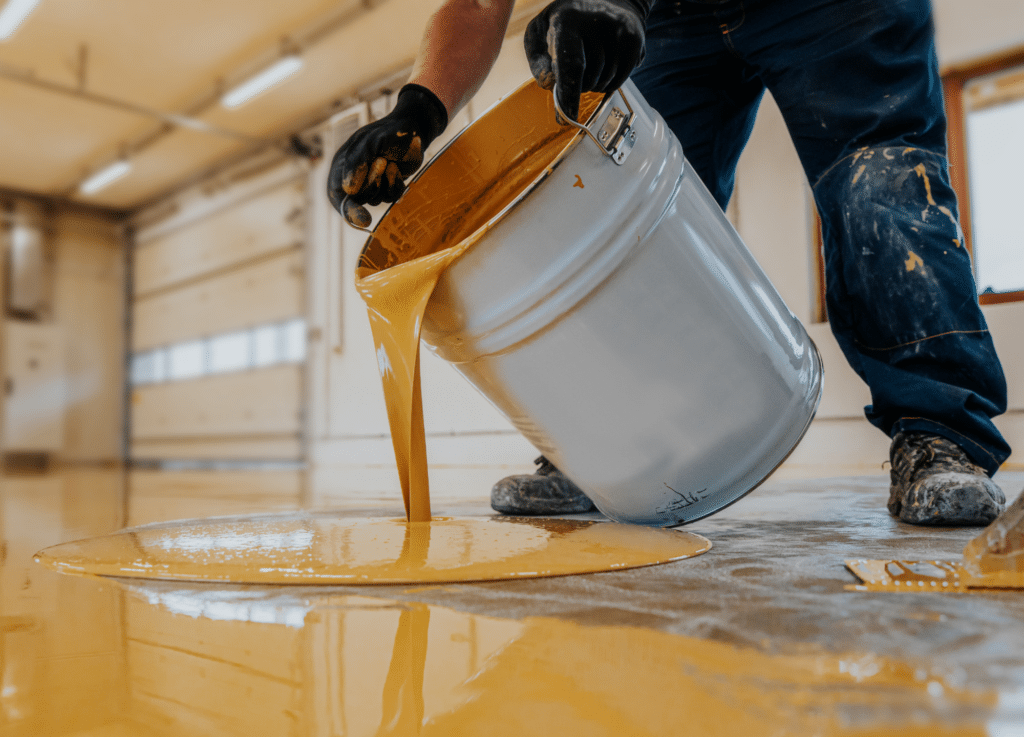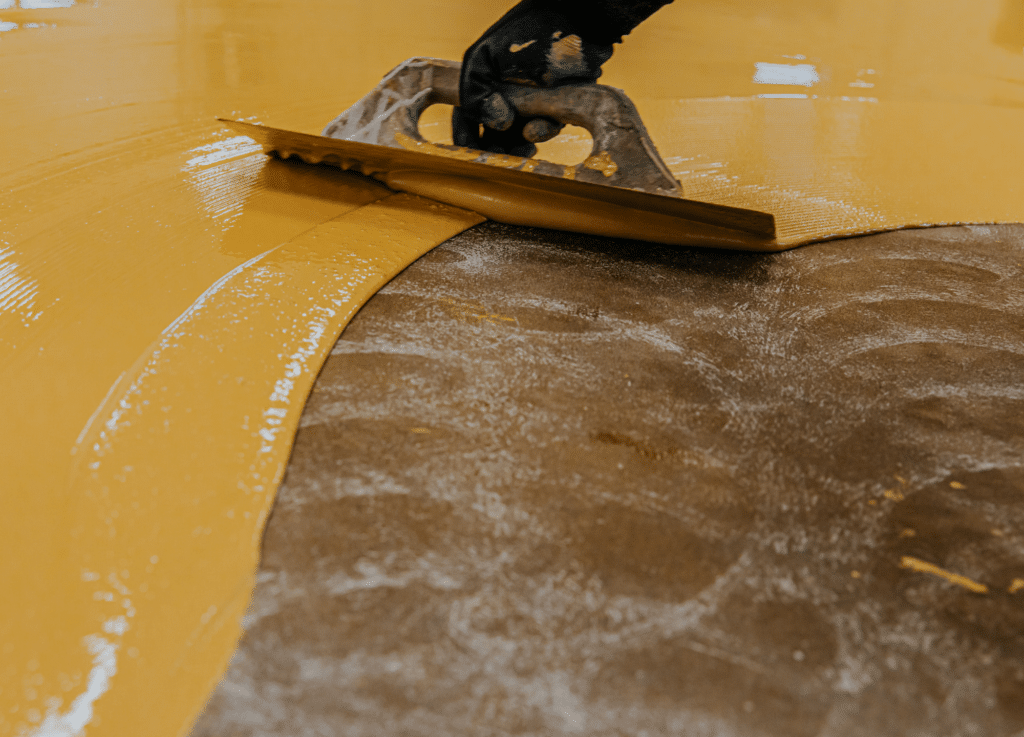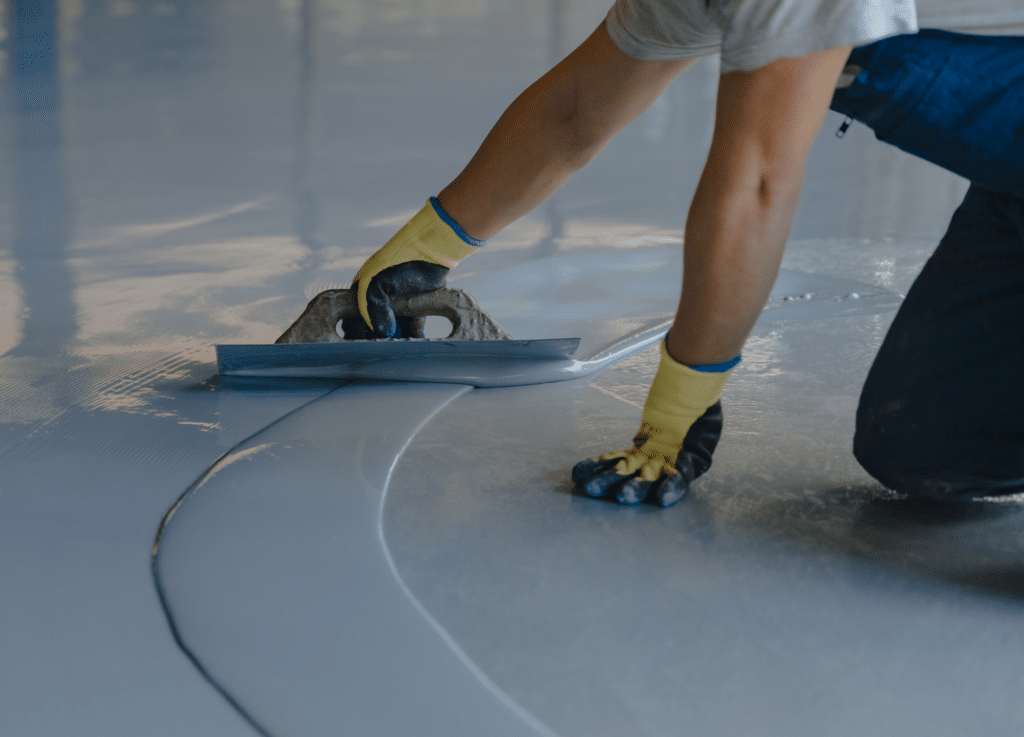DJ Corporate Solutions: Epoxy Flooring, Epoxy Countertops, and Interior & Exterior Painting Services
In the current surge of home renovation and interior design, the once-industrial epoxy flooring has made its way into the hearts and homes of many. Epoxy floors are garnering attention for their seamless and polished finish that can transform a space from mundane to modern. However, like all design choices, there are numerous considerations before committing to any flooring investment. This comprehensive post dissects the pros and cons of epoxy floors, helping homeowners and design enthusiasts make an informed decision when it comes to revamping their interiors.
Often considered for garage floors due to its durability and resistance to stains, epoxy floor coating has proven to be a robust option for areas subjected to heavy foot traffic. Unlike the traditional concrete floors found in many homes, epoxy provides a level of sheen that concrete simply cannot match. This floor coating isn’t just about aesthetics; it also seals and protects the floors, making them more resistant to spills, chemicals, and wear over time. However, it’s pivotal for homeowners to consider how this feature translates to other areas of the home beyond the garage, especially in spaces with different types of foot traffic and usage.

Introduction to Epoxy Floors
Epoxy flooring is made up of a two-part resin that, when mixed, starts a chemical reaction, creating a rigid plastic material. This material bonds incredibly well to most base layers. In the past, it was primarily used for industrial spaces due to its high durability and chemical resistance. Today, it’s a hot trend in residential design, particularly in areas like garages, basements, and even living rooms and kitchens. The liquid-to-solid application process makes it customizable and allows for a variety of finishes, from high-gloss to matte.
Given its origin as a preferred choice for garage floors, the transition of epoxy coating into residential spaces underscores its versatility and durability. Not only does it offer a robust protection against the rigors of everyday life, such as spills and heavy foot traffic, but it also presents a myriad of decorative options. Homeowners now have the flexibility to incorporate a range of colors, patterns, and even metallic effects into their flooring, transforming a functional garage floor into a statement piece within their home. This adaptability allows for personalization and creativity in home design, making epoxy coating a compelling option for those looking to blend utility with aesthetics.
Pros of Epoxy Floors
Durability and Longevity
Epoxy floors are renowned for their remarkable durability. They can withstand heavy loads, making them a smart choice for high-traffic areas. When properly maintained, they can last for decades without needing a replacement. Unlike other types of flooring, epoxy does not chip, crack, or peel easily.
Furthermore, floor coating such as epoxy is highly resistant to harsh chemicals, which makes it an ideal choice for workshops or areas where such substances might be used. In addition to resisting chemical stains and spills, epoxy floors are also known for their low odor during and after application, making them less intrusive to indoor air quality compared to other flooring options. Besides this, another significant advantage of epoxy as a floor coating is its ability to withstand UV exposure, ensuring that the vibrant colors and glossy sheen don’t fade over time. This comprehensive protection helps to maintain the flooring’s aesthetic appeal while extending its lifespan, thereby offering homeowners a durable and aesthetically pleasing solution to protect their flooring investment.
Aesthetic Appeal and Design Options
The sheen and seamless finish of epoxy floors can give your home a sleek and professional look. Epoxy can be customized with a variety of colors, patterns, and textured effects, allowing homeowners to create a unique aesthetic. This versatility ensures that your epoxy flooring complements your interior design scheme.
Additionally, techniques such as adding a layer of stone coat or mixing two colors of epoxy can create stunning visual effects, reminiscent of natural stone or abstract art. This approach, combined with the utilization of self-leveling epoxy, ensures a smooth and even surface, enhancing the overall aesthetics of the flooring. The application of a top coat not only magnifies the brilliance of the underlying colors but also serves as an extra layer of protection. With these methods, epoxy flooring transcends its utilitarian origins, allowing homeowners to cover their existing concrete paint with a robust and visually striking surface that embodies their personal style and taste.
Easy Maintenance and Cleaning
Maintaining epoxy floors is relatively simple. Their non-porous surface prevents dirt and spills from seeping in, making cleaning a breeze. A regular dust mop or soft bristle broom, along with occasional mopping with a mild detergent, can keep your epoxy floor looking as good as new.
Resistance to Chemicals and Stains
Epoxy floors are a perfect solution for households where spills and messes are a common occurrence. They are resistant to a wide range of chemicals, including oil, gasoline, and household cleaners. In addition, the non-porous nature of epoxy prevents stains from setting in.
Despite its strengths, it’s important to be aware of the varying types of epoxy floor coatings, including water-based and solvent-based options, as they affect the levels of volatile organic compounds (VOCs) emitted. Water-based epoxy is a more environmentally friendly option, with lower VOC levels, making it safer for residential use, especially in enclosed spaces like garages. A top coat can further enhance the durability of the epoxy, making it even more resistant to harsh chemicals and ensuring that the surface remains durable and long-lasting. This is particularly valuable in settings that mimic industrial applications, where the floor must withstand rigorous use and exposure to substances that could degrade lesser materials. Thus, choosing the right type of epoxy, along with a protective top coat, is crucial in maximizing the robustness and longevity of your garage floor or any surface where epoxy is applied.
Cons of Epoxy Floors

Initial Installation Cost
One of the major drawbacks of epoxy flooring is the cost of installation. The process typically requires surface preparation, which can be labor-intensive and time-consuming. This, coupled with the high-quality materials, can result in a significantly higher installation cost compared to traditional flooring options.
However, it’s important to consider that the higher upfront cost of epoxy floor coating can be offset by its longevity and durability. Opting for thicker epoxy applications during the initial installation process, under professional guidance, can enhance the floor’s resistance to wear and tear, ultimately proving to be a cost-effective choice in the long run. Homeowners can save money by reducing the need for frequent repairs or replacements. Investing in a high-quality primer and material can also extend the working time and durability of the epoxy coating, further maximizing the investment. Thus, while the initial installation cost may be higher, the extended lifespan and reduced maintenance requirements of professionally installed epoxy floors provide significant financial advantages over time.
Slippery When Wet
Epoxy floors, especially high-gloss finishes, can become slippery when wet, increasing the risk of accidents. Homeowners with kids or the elderly might want to consider this potential safety hazard.
To mitigate the slipperiness and enhance the safety of epoxy-coated surfaces, particularly in homes with children or elderly residents, integrating material additives offering a non-slip texture is advisable. By including a final coat that incorporates a urethane hardener, not only does the safety feature improve, but the durability against abrasion and chemical spills is significantly increased. This coat, applied after the epoxy resin has been mixed with its hardener and primer, ensures a robust bond with the underlying surface.
Potential for Yellowing Over Time
Exposure to UV light can cause some epoxy floors to yellow over time. While this might not be a problem in areas with little to no natural light, it can be a concern for spaces that receive significant sunlight, such as sunrooms or patios converted to living spaces.Urethane, known for its resistance to UV rays, also prevents the yellowing that can occur with epoxy resin when exposed directly to sunlight. This combination promotes an enduring vibrancy and structural integrity of the material, safeguarding the aesthetic and functional qualities of the surfaces.
Limited Repair Options
Unlike wood or tile floors that can be repaired by replacing individual pieces, fixing a damaged epoxy floor can be challenging. In most cases, the repair involves re-coating the entire floor, which can be a costly and involved process.
Considerations for Homeowners
Weighing the Factors Before Installation
Before deciding on epoxy floors, homeowners should consider the following factors:
- The intended use of the space
- The desired look and feel
- The budget, including both the installation costs and the potential repair or re-coating expenses over time
Maintenance Tips for Epoxy Floors
To get the most out of your epoxy floors:
- Perform routine cleaning to avoid a buildup of dirt and contaminants.
- Address spills and stains immediately to prevent discoloration.
- Use gentle cleaning methods to prolong the life and appearance of your floors.
Comparison with Traditional Flooring Options
Epoxy floors offer distinct advantages over traditional flooring options. Compared to carpet, they are easier to clean and offer better resistance to damage. When compared to hardwood, epoxy floors are far more durable and require less maintenance. However, they lack the warmth and natural feel of wood.
In the end, the decision to install epoxy floors in your home is a personal one that should be guided by your specific needs, preferences, and the nuances of your living environment. While the initial cost and potential downsides of epoxy flooring are noteworthy, the material’s many benefits and the stunning transformations it can bring to a space cannot be overlooked.
Epoxy floors represent a significant shift in domestic design, offering a balance of form and function that caters to the demands of modern living. For those willing to invest in the initial cost and commit to the ongoing maintenance, epoxy floors can be a valuable addition to any home. However, it’s crucial to weigh all the pros and cons before making a final decision.
Ultimately, whether you choose epoxy floors for their strength and style or opt for a more traditional flooring type that offers a different set of advantages, thoughtful consideration and informed decision-making will ensure that your home’s flooring serves you well for years to come.

FAQs
What are the best practices for epoxy flooring on garage floors?
To ensure the long-term durability and aesthetic appeal of epoxy flooring on garage floors, it’s important to begin with thorough surface prep, including cleaning and moisture testing. The garage floor should be free from oils, grease, and other contaminants that can affect the adhesion of the epoxy. After prep, apply a primer before the epoxy layer, and consider a top coat for extra protection and to extend the life of your flooring.
How can I protect my epoxy flooring from stains and damage?
To protect your epoxy flooring from stains and damage, clean spills immediately, especially from harsh chemicals. Consider using a protective topcoat that offers additional resistance to stains and abrasions. Regular maintenance, such as sweeping and gentle mopping, can also prevent dirt buildup that can scratch and dull the surface.
How much does epoxy flooring cost per square foot?
The cost of epoxy flooring can vary widely depending on several factors such as the condition of the concrete, the type of epoxy used, and the complexity of the job. On average, homeowners might expect to pay between $3 and $12 per square foot. High-end, decorative finishes or extensive surface prep can increase the cost.
Can epoxy flooring save money in the long run?
Yes, epoxy flooring can save money over time due to its durability and low maintenance needs. By reducing the need for frequent repairs or replacements compared to more traditional flooring options, homeowners can enjoy long-term savings. Additionally, the protective qualities of epoxy can extend the life of the underlying concrete.
When does the product begin to cure, and how long does it take?
Epoxy typically begins to cure once the two components (resin and hardener) are mixed. The entire curing process can take anywhere from several hours to a few days, depending on the specific product, temperature, and humidity. It’s crucial to follow the manufacturer’s instructions for the best results.
Does epoxy flooring come in a kit, and what does it include?
Yes, epoxy flooring often comes in a kit designed for DIY installations. A typical kit includes epoxy resin, hardener, a mixing stick, and sometimes decorative chips or color pigments. Some kits may also include prep and cleaning solutions. Always check the kit contents before purchasing to ensure you have everything needed for your project.
How can I manage moisture issues with epoxy flooring in a basement?
For basements, addressing moisture issues before applying epoxy is crucial to prevent bubbling and peeling. Conduct a moisture test and ensure proper drainage and waterproofing measures are in place. Selecting a moisture-resistant epoxy product and possibly integrating a vapor barrier can offer added protection against moisture-related problems.
Are there a variety of color options available for epoxy flooring?
Epoxy flooring comes in a wide range of colors and finishes, from solid colors to metallic effects and decorative patterns. This variety makes it easy to match your flooring to the existing decor or achieve a specific aesthetic. Custom color mixes are also possible with some manufacturers.
Is epoxy flooring water-proof?
Epoxy flooring is highly resistant to water and can effectively protect the underlying concrete from moisture damage. While epoxy can handle spills and moisture well, it’s essential to address large amounts of water or underlying issues that may compromise the integrity of the flooring.

